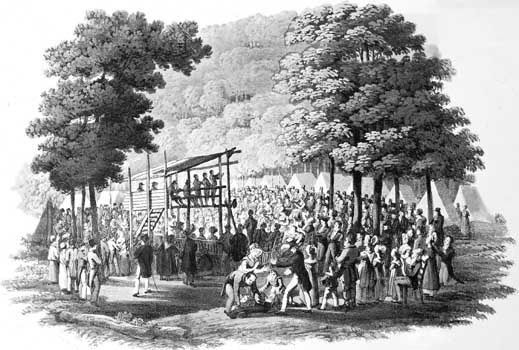revitalization movement
 organized attempt to create a more satisfying culture, with the new culture often modeled after previous modes of living. Nativistic, revivalistic (revivalism), messianic (messiah), millenarian, and utopian (utopia) movements are all varieties of revitalization movements, according to anthropologist Anthony F.C. Wallace (Wallace, Anthony F.C.), who introduced the term. Any given movement may contain elements of several of these varieties.
organized attempt to create a more satisfying culture, with the new culture often modeled after previous modes of living. Nativistic, revivalistic (revivalism), messianic (messiah), millenarian, and utopian (utopia) movements are all varieties of revitalization movements, according to anthropologist Anthony F.C. Wallace (Wallace, Anthony F.C.), who introduced the term. Any given movement may contain elements of several of these varieties.Social scientists generally agree that revitalization movements are societal responses to excessive stress. However, several mutually exclusive theories have been proposed to explain the generation of a revitalization movement: acculturation holds that conquest and other forms of hegemony generate utopian movements; social evolution views revitalization movements as expressions of empowerment by disadvantaged classes or groups; and absolute deprivation posits that dissatisfaction with a low standard of living leads people to adopt a revolutionary ideology. The most widely accepted theory, relative deprivation, suggests that revitalization movements may occur when a significant proportion of a society finds its status and economic circumstances trailing those of the rest of society, even if the dissatisfied group has a relatively high standard of living according to independent economic measures or in comparison to its past standard of living.
Revitalization movements usually have at their head one or more prophets or charismatic leaders who initiate the call for social transformation. Instances of revitalization movements include early Methodism (1738–1800, in England and the United States), the Shaker movement (from 1774, in the United States), the Ghost Dance among the North American Plains Indians (Plains Indian) (1888–90), the Sudanese Mahdists (Mahdist) (from the late 19th century), the Boxer movement (Boxer Rebellion) (1898–1900, China), and the Mau Mau movement (Mau Mau) (1950s, Kenya).
- Dixon Entrance
- Dixon, Floyd
- Dixon, George
- Dixon, Henry Horatio
- Dixon, Jeremiah
- Dixon, Joseph
- Dixon, Roland B
- Dixon, Thomas
- Dixon, Willie
- Dix, Otto
- diyah
- Diyarbakır
- Diyālā River
- Dizzy Dean
- Dizzy Gillespie
- Diémer, Louis-Joseph
- Diószegi, Vilmos
- Django Reinhardt
- Dja River
- Djebar, Assia
- Djelfa
- Djenné
- D.J. Enright
- Djibouti
- Djibouti, flag of